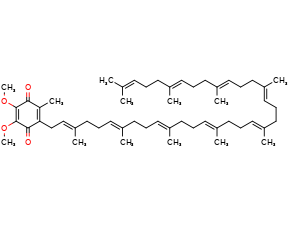
Coenzyme Q9
CAS No. 303-97-9
Coenzyme Q9( Ubiquinone Q9 | CoQ9 | Ubiquinone 9 )
Catalog No. M20175 CAS No. 303-97-9
Coenzyme Q9 (CoQ9) is a normal constituent of human plasma. CoQ9 in human plasma may originate as a product of incomplete CoQ10 biosynthesis or from the diet.
Purity : >98% (HPLC)
 COA
COA
 Datasheet
Datasheet
 HNMR
HNMR
 HPLC
HPLC
 MSDS
MSDS
 Handing Instructions
Handing Instructions
| Size | Price / USD | Stock | Quantity |
| 5MG | 115 | In Stock |


|
| 10MG | 171 | In Stock |


|
| 25MG | 255 | In Stock |


|
| 50MG | 376 | In Stock |


|
| 100MG | 561 | In Stock |


|
| 200MG | Get Quote | In Stock |


|
| 500MG | Get Quote | In Stock |


|
| 1G | Get Quote | In Stock |


|
Biological Information
-
Product NameCoenzyme Q9
-
NoteResearch use only, not for human use.
-
Brief DescriptionCoenzyme Q9 (CoQ9) is a normal constituent of human plasma. CoQ9 in human plasma may originate as a product of incomplete CoQ10 biosynthesis or from the diet.
-
DescriptionCoenzyme Q9 (CoQ9) is a normal constituent of human plasma. CoQ9 in human plasma may originate as a product of incomplete CoQ10 biosynthesis or from the diet.
-
In Vitro——
-
In VivoAnimal Model:Male Hartley guinea pigs of about 350-400 g body weight Dosage:5 mg/kg of body weight Administration:P.o.; once a day for 4 weeks Result:Nutritional supplementation of CoQ9 can reduce myocardial ischemia/reperfusion injury to the same extent as CoQ10.
-
SynonymsUbiquinone Q9 | CoQ9 | Ubiquinone 9
-
PathwayProteasome/Ubiquitin
-
TargetEndogenous Metabolite
-
RecptorHuman Endogenous Metabolite
-
Research Area——
-
Indication——
Chemical Information
-
CAS Number303-97-9
-
Formula Weight795.23
-
Molecular FormulaC54H82O4
-
Purity>98% (HPLC)
-
SolubilityDMSO:5 mg/mL?(6.29 mM)
-
SMILESCOC1=C(OC)C(=O)C(C\C=C(/C)CC\C=C(/C)CC\C=C(/C)CC\C=C(/C)CC\C=C(/C)CC\C=C(/C)CC\C=C(/C)CC\C=C(/C)CC\C=C(\C)C)=C(C)C1=O
-
Chemical Name——
Shipping & Storage Information
-
Storage(-20℃)
-
ShippingWith Ice Pack
-
Stability≥ 2 years
Reference
1.Lekli I et al. Coenzyme Q9 provides cardioprotection after converting into coenzyme Q10. J Agric Food Chem. 2008 Jul 9;56(13):5331-7.
molnova catalog



related products
-
Cyclopentanone
Cyclopentanone is found in animal foods.
-
L-23-Diaminopropioni...
L-23-diaminopropionic acid is an amino acid that is a precursor of antibiotics and staphyloferrin B a siderophore produced by Staphylococcus aureus.
-
Lipoxin A4
Lipoxin A4 (LXA4) is a lipoxygenase-derived arachidonate-like mediator with anti-inflammatory properties.Lipoxin A4 attenuates MSU crystal-induced NLRP3 inflammasome activation through inhibition of Nrf2, and regulates M1/M2 macrophage polarization through the FPR2-IRF pathway.



 Cart
Cart
 sales@molnova.com
sales@molnova.com


